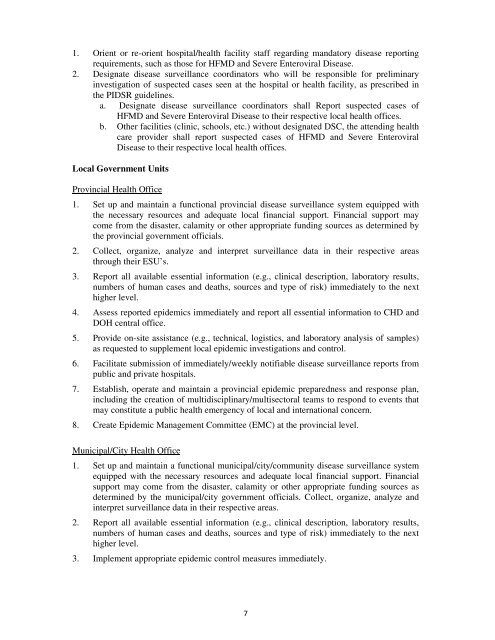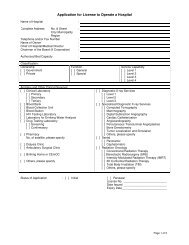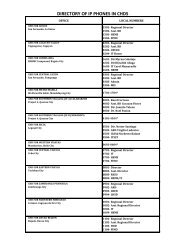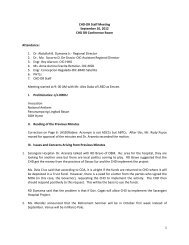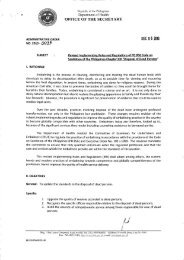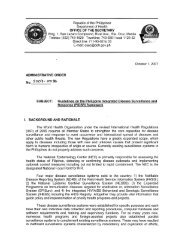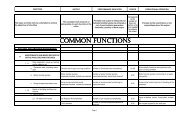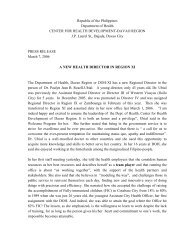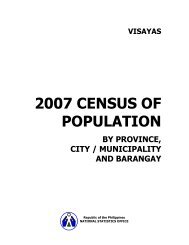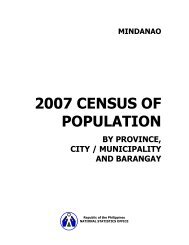Interim Guidelines on Surveillance of HFMD - CHD-Davao Region
Interim Guidelines on Surveillance of HFMD - CHD-Davao Region
Interim Guidelines on Surveillance of HFMD - CHD-Davao Region
Create successful ePaper yourself
Turn your PDF publications into a flip-book with our unique Google optimized e-Paper software.
1. Orient or re-orient hospital/health facility staff regarding mandatory disease reportingrequirements, such as those for <strong>HFMD</strong> and Severe Enteroviral Disease.2. Designate disease surveillance coordinators who will be resp<strong>on</strong>sible for preliminaryinvestigati<strong>on</strong> <strong>of</strong> suspected cases seen at the hospital or health facility, as prescribed inthe PIDSR guidelines.a. Designate disease surveillance coordinators shall Report suspected cases <strong>of</strong><strong>HFMD</strong> and Severe Enteroviral Disease to their respective local health <strong>of</strong>fices.b. Other facilities (clinic, schools, etc.) without designated DSC, the attending healthcare provider shall report suspected cases <strong>of</strong> <strong>HFMD</strong> and Severe EnteroviralDisease to their respective local health <strong>of</strong>fices.Local Government UnitsProvincial Health Office1. Set up and maintain a functi<strong>on</strong>al provincial disease surveillance system equipped withthe necessary resources and adequate local financial support. Financial support maycome from the disaster, calamity or other appropriate funding sources as determined bythe provincial government <strong>of</strong>ficials.2. Collect, organize, analyze and interpret surveillance data in their respective areasthrough their ESU’s.3. Report all available essential informati<strong>on</strong> (e.g., clinical descripti<strong>on</strong>, laboratory results,numbers <strong>of</strong> human cases and deaths, sources and type <strong>of</strong> risk) immediately to the nexthigher level.4. Assess reported epidemics immediately and report all essential informati<strong>on</strong> to <strong>CHD</strong> andDOH central <strong>of</strong>fice.5. Provide <strong>on</strong>-site assistance (e.g., technical, logistics, and laboratory analysis <strong>of</strong> samples)as requested to supplement local epidemic investigati<strong>on</strong>s and c<strong>on</strong>trol.6. Facilitate submissi<strong>on</strong> <strong>of</strong> immediately/weekly notifiable disease surveillance reports frompublic and private hospitals.7. Establish, operate and maintain a provincial epidemic preparedness and resp<strong>on</strong>se plan,including the creati<strong>on</strong> <strong>of</strong> multidisciplinary/multisectoral teams to resp<strong>on</strong>d to events thatmay c<strong>on</strong>stitute a public health emergency <strong>of</strong> local and internati<strong>on</strong>al c<strong>on</strong>cern.8. Create Epidemic Management Committee (EMC) at the provincial level.Municipal/City Health Office1. Set up and maintain a functi<strong>on</strong>al municipal/city/community disease surveillance systemequipped with the necessary resources and adequate local financial support. Financialsupport may come from the disaster, calamity or other appropriate funding sources asdetermined by the municipal/city government <strong>of</strong>ficials. Collect, organize, analyze andinterpret surveillance data in their respective areas.2. Report all available essential informati<strong>on</strong> (e.g., clinical descripti<strong>on</strong>, laboratory results,numbers <strong>of</strong> human cases and deaths, sources and type <strong>of</strong> risk) immediately to the nexthigher level.3. Implement appropriate epidemic c<strong>on</strong>trol measures immediately.7


